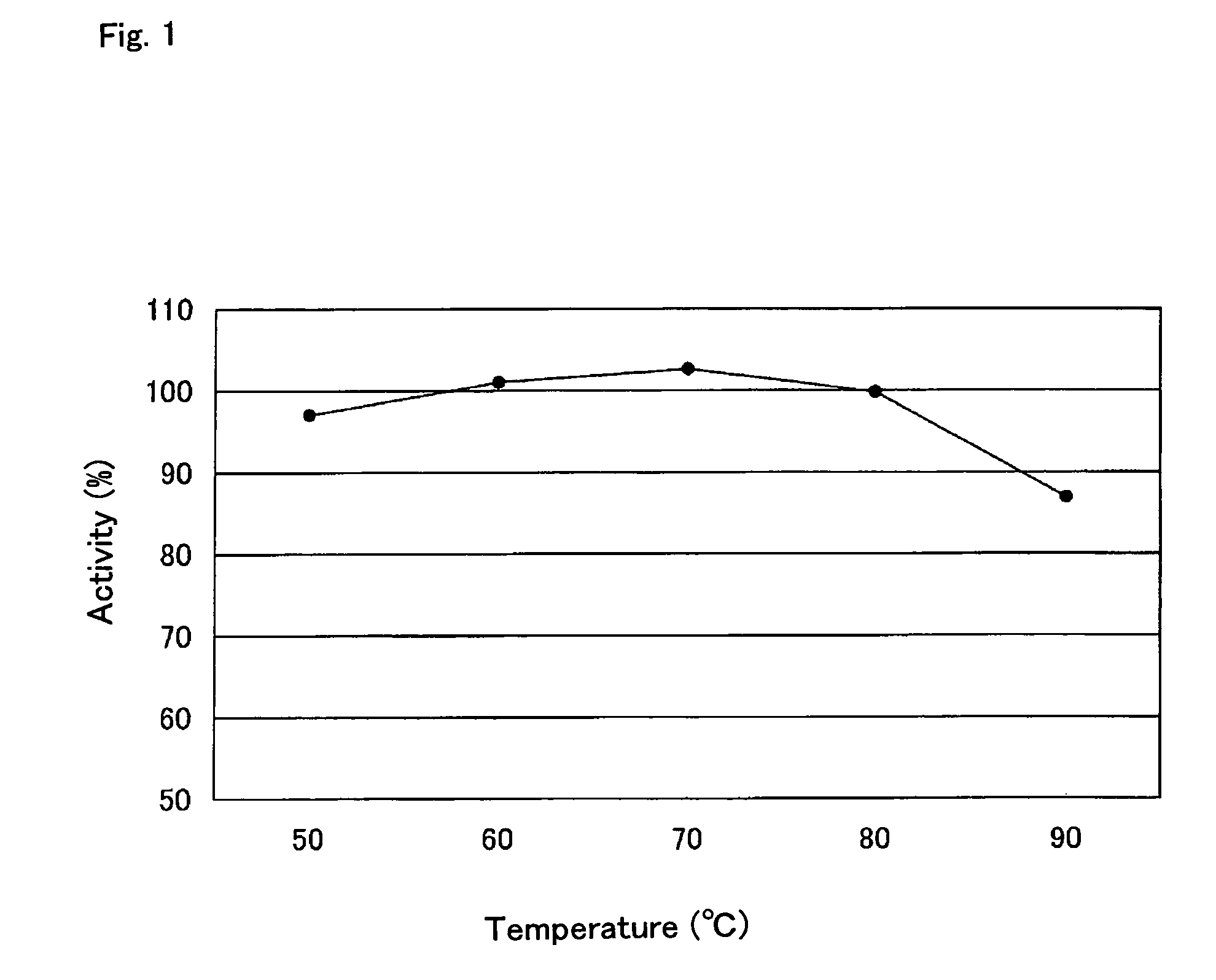Thermostable ribonuclease H obtained from Archeoglobus profundus
a ribonuclease and thermostable technology, applied in the field of polypeptides, can solve the problems of reduced activity on a. dna-, low expression level of rnase h, and low thermostability, and achieve the effect of high rnase h activity
- Summary
- Abstract
- Description
- Claims
- Application Information
AI Technical Summary
Benefits of technology
Problems solved by technology
Method used
Image
Examples
example 1
Cloning of Archaeoglobus profundus RNase H Gene
[0088](1) Preparation of Genomic DNA from Archaeoglobus profundus
[0089]Cells of Archaeoglobus profundus (purchased from Deutsche Sammlung von Mikroorganismen und Zellkulturen GmbH; DSM5631) collected from 10 ml of a culture were suspended in 100 μl of a mixture containing 20% sucrose and 50 mM tris-HCl (pH 8.0). 20 μl of 0.5 M EDTA and 10 μl of 10 mg / ml aqueous solution of lysozyme chloride (Nacalai Tesque) were added thereto. The mixture was reacted at 20° C. for 2 hours. After reaction, 800 μl of a mixture containing 150 mM NaCl, 1 mM EDTA and 20 mM tris-HCl (pH 8.0), 10 μl of 20 mg / ml proteinase K (Takara Bio) and 50 μl of 10% aqueous solution of sodium lauryl sulfate were added to the reaction mixture. The mixture was incubated at 37° C. for 1 hour. After reaction, the mixture was subjected to phenol-chloroform extraction, ethanol precipitation and air-drying. The precipitate was then dissolved in 50 μl of TE to obtain a genomic DN...
example 2
Homology Search
[0120]Homology searches were conducted for the amino acid sequence of RNase H from Archaeoglobus profundus (Apr) obtained in Example 1 and the nucleotide sequence encoding the same. Calculation of homology was conducted using a computer algorithm FASTA (version 3.2; Pearson, W. R. et al., Pro. Natl. Acad. Sci., 85:2444-2448, 1988) as a search program.
[0121]Gene database searches were conducted for Apr RNase H using the computer algorithm FASTA. As a result, the highest homologies between the amino acid and nucleotide sequences of Apr RNase H and those of one presumed to be of a ribonuclease were 53% and 60%, respectively.
example 3
Examination of Thermostability of RNase H
[0122]Thermostability of Archaeoglobus profundus RNase H was examined using Escherichia coli transformed with pApr108 obtained in Example 1-(6). The E. coli strain was cultured, a crude enzyme extract prepared from the culture was heated at 95° C. for 15 minutes, and the RNase H activity was determined according to the method as described in Example 1-(6). As a result, an RNase H activity was observed for the RNase H derived from Archaeoglobus profundus.
[0123]In addition, Apr RNase H at a concentration of 5. units / ml in a heat treatment buffer (25 mM tris-HCl (pH 8.0), 5 mM mercaptoethanol, 30 mM NaCl, 0.5 mM EDTA, 0.1% BSA, 50% glycerol) was heated for 10 minutes at 50, 60, 70, 80 or 90° C., and the remaining activity was determined. The sample with or without heat treatment was added, at a final concentration of 0.2 units / ml, to an activity measurement solution (at final concentrations, 32 mM HEPES-potassium hydroxide buffer (pH 7.8), 100 ...
PUM
| Property | Measurement | Unit |
|---|---|---|
| temperature | aaaaa | aaaaa |
| pH | aaaaa | aaaaa |
| concentration | aaaaa | aaaaa |
Abstract
Description
Claims
Application Information
 Login to View More
Login to View More - R&D
- Intellectual Property
- Life Sciences
- Materials
- Tech Scout
- Unparalleled Data Quality
- Higher Quality Content
- 60% Fewer Hallucinations
Browse by: Latest US Patents, China's latest patents, Technical Efficacy Thesaurus, Application Domain, Technology Topic, Popular Technical Reports.
© 2025 PatSnap. All rights reserved.Legal|Privacy policy|Modern Slavery Act Transparency Statement|Sitemap|About US| Contact US: help@patsnap.com

